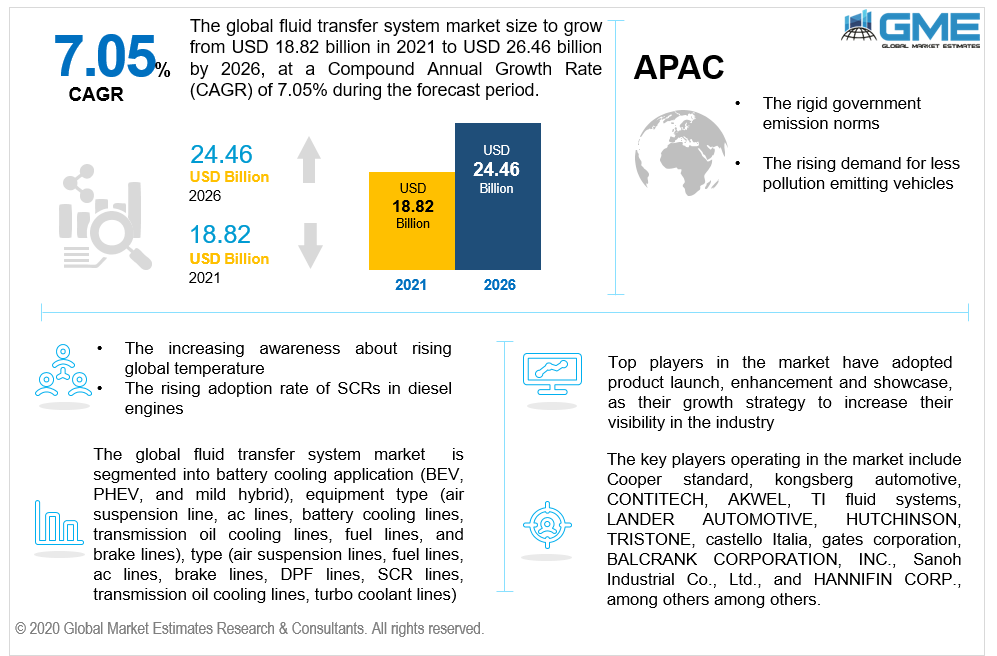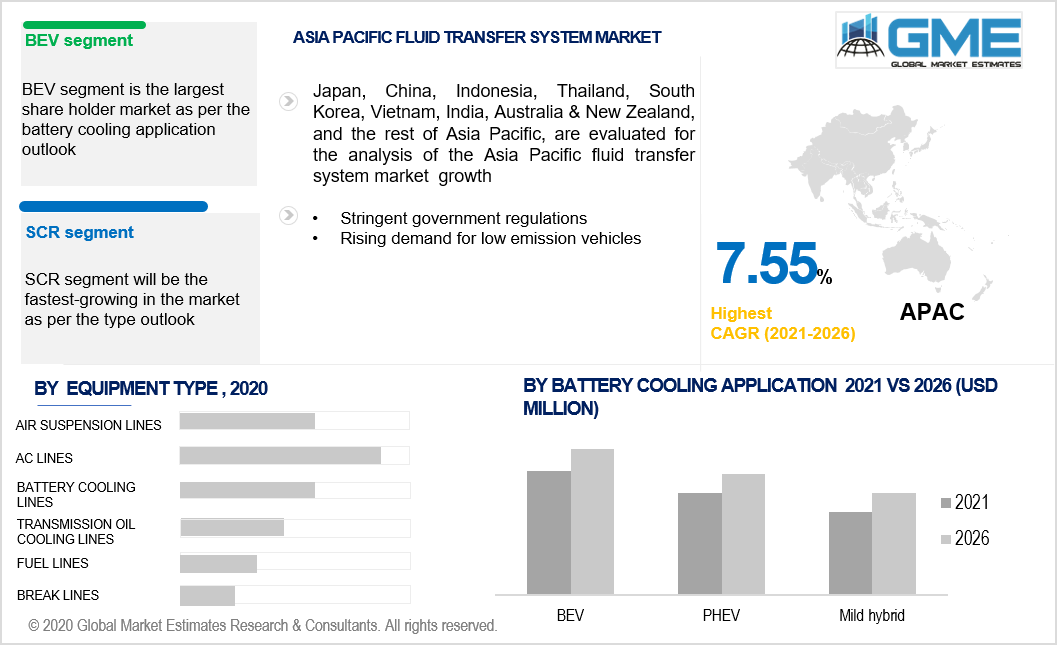
Fluid Transfer System Market Size, Trends & Analysis – Forecasts to 2026 By Battery cooling application (BEV, PHEV, and Mild hybrid), By Equipment Type (Air suspension line, AC lines, Battery cooling lines, Transmission oil cooling lines, Fuel lines, and Brake lines), By Type (Air suspension lines, Fuel lines, AC lines, Brake lines, DPF lines, SCR lines, Transmission oil cooling lines, Turbo coolant lines), By Region (North America, Europe, Asia Pacific, MEA, and CSA).
The government efforts towards fuel efficiency and emission reduction in forms of policies and regulations is the main factor leading to the growth of the market of the fluid transfer system.
The fluid transfer systems can offer efficient and secure loading as well as offloading in various onshore and offshore applications. This system uses flexible pipes for moving crude oil and other such substance into complex applications which include means for deploying, processing, and recovering flexible pipes, control, and utility equipment. The market for fluid transfer systems consists of several global and regional organic and inorganic growth strategies.
The light-weighting trend in vehicles is also a driving force for the market of the fluid transfer system. Lightweight automotive materials are gaining momentum in the global automotive industry. The growing popularity of lightweight vehicles globally is boosting the market growth. Lightweight materials are commonly used to improve both the protection and overall performance of the vehicle.
The increasing adoption rate of SCRs (Selective Catalytic Reduction) in diesel engines, as SCR technology reduces emissions by injecting a reduction agent based on urea into the exhaust system of a diesel engine through a catalyst. The growing demand for luxury vehicles among developing and developed nations are supporting the market growth. Increasing usage and adoption of electric vehicles are boosting the market.

The BEV (battery electric vehicles) segment is expected to be the dominating segment in the globalmarket due to the rising demand forBEV worldwide. BEVs only have an electric motor and their battery pack is their only source of power; therefore, 100 percent of the time, they deliver zero-emission driving. This demand is also supported by attractive government policies and subsidies around the world for zero-emission from vehicles.
The PHEV (plug-in hybrid electric vehicles) segment is estimated to witness a growth in the market due to its ability to risepower or additional auxiliary power for electronic devices and power tools, improve the fuel economy, and decrease emissions.The larger battery allows the PHEV the power to go much farther on the electric motor alone and quicker than a full hybrid. PHEVs also offer far more zero-emission driving than total hybrids, not only making a big difference to the fuel economy.
Based on the equipment type, the market is classified into air suspension lines, brake lines, ac lines, fuel lines, battery cooling lines, and transmission oil cooling lines among others. The AC lines segment will be the dominating segment and will generate huge revenues between 2021-2026. The increasing awareness about global warming in the world, and the changing lifestyles of people to eco-friendlier products and services, are supporting the market growth. Growing advanced cooling technological developments to filter the air within vehicles, and rapid industrialization requiring to have better air filtering techniques for maintaining the global temperature.
Almost all assembled vehicles are fitted with an air conditioning system. Thus, to provide enhanced comfort, there is a tough rivalry between automakers. This rivalry has intensified pressure on OEMs to produce automotive air conditioning systems that are technologically advanced. Adopting the rear AC system has also been motivated by the growing popularity of luxury vehicles.
The SCR lines segment is the emerging segment in the market. SCR lines are majorly preferred for passenger cars and LCVS vehicles. The growing environmental concerns and stringent emission norms are driving manufacturers to adopt SCR lines in passenger vehicles. SCR lines are the most efficient technologies to reduce vehicular emissions.

Due to strict government regulations in the region, increased demand for less pollution-emitting vehicles, and the growing perception of rising global temperatures, the Asia Pacific region is expected to be dominating the fluid transfer system market. China is renowned for being the largest market for Gasoline Direct Injection (GDI) engines to track compliance with emission standards. The growing production and sales of lightweight vehicles in China and India are boosting the market growth for fluid transfer systems.
The European region is also known well for emission control rules and regulations because of which the fluid transfer systems market will witness a decent demand in the region. The major manufacturers in the European region are trying to develop zero-emission vehicles.The presence of luxury automobile manufacturers such as Benz, Audi, Porch, and Ferrari is supporting the market growth in the region.
Cooper standard, CONTITECH, Kongsberg automotive, AKWEL, LANDER AUTOMOTIVE, TI fluid systems, HUTCHINSON, Castello Italia, TRISTONE, gates corporation, Sanoh Industrial Co., Ltd., BALCRANK CORPORATION, INC., and HANNIFIN CORP.,among others are the key companies involved in supplying fluid transfer systems.
Please note: This is not an exhaustive list of companies profiled in the report.
In November 2020, TI Fluid Systems has begun the development of new high-scale thermal products, assemblies, and innovations for new battery-powered electric vehicles. Expanding its material category by adding lightweight engineering polymer to it for thermal coolant loop line assemblies.
In July 2019, CONTITECH acquired Merlett group flexible hose business. The company was able to extend its material division concerning high-performance thermoplastics technologies because of this agreement.
We value your investment and offer free customization with every report to fulfil your exact research needs.
The Global Fluid Transfer System Market has been studied from the year 2019 till 2026. However, the CAGR provided in the report is from the year 2021 to 2026. The research methodology involved three stages: Desk research, Primary research, and Analysis & Output from the entire research process.

The desk research involved a robust background study which meant referring to paid and unpaid databases to understand the market dynamics; mapping contracts from press releases; identifying the key players in the market, studying their product portfolio, competition level, annual reports/SEC filings & investor presentations; and learning the demand and supply-side analysis for the Fluid Transfer System Market.

The primary research activity included telephonic conversations with more than 50 tier 1 industry consultants, distributors, and end-use product manufacturers.

Finally, based on the above thorough research process, an in-depth analysis was carried out considering the following aspects: market attractiveness, current & future market trends, market share analysis, SWOT analysis of the company and customer analytics.

Tailor made solutions just for you
80% of our clients seek made-to-order reports. How do you want us to tailor yours?
OUR CLIENTS